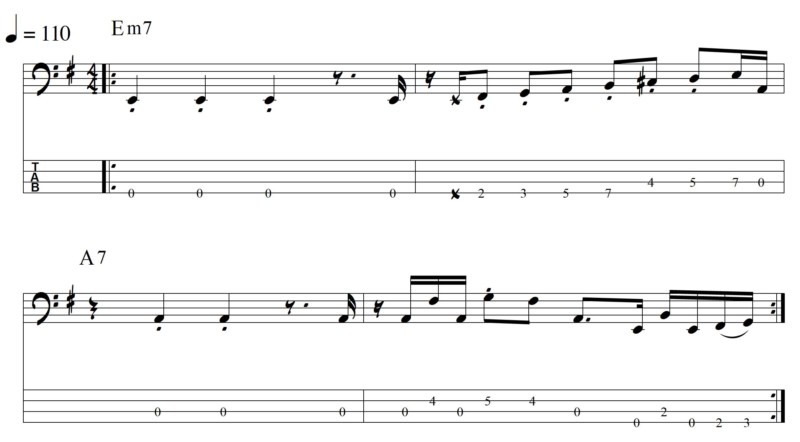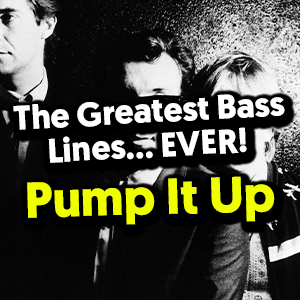This week we’re going to be looking at one of the most famous bass riffs ever: Good Times by Chic.
This awesome riff is played by the one of the funkiest bass players of all time Bernard Edwards. We’re going to look at some of the 16th note rhythms in there and the chord tone outline of the progression.
Good Times
First, as always, let’s work through that riff. It’s in E minor and originally played at 110 beats per minute:

Those pesky 16th notes!
One of the most important aspects you need to nail in this riff is the rhythm. Most of the riff is actually pretty straightforward. To begin, we’ve got simple hits on the beat and then we’ve got straight 8th notes on the climb up through the scale. But we’ve also got some little syncopated 16th notes acting as anticipations for bars 2, 3 and 4.
The gaps preceding those 16th notes can cause the line to be sloppy and that can result in a rhythm section lacking that ‘tight’ feel.
The key to dealing with those gaps and the 16th notes is to subdivide. You can count 1 e and a 2 e and a etc. or you can use your own vocalisations (as demonstrated in the video). Either way, you need to be counting along through that space. Yes, you might be able to simply feel it OK without any counting and subdividing but if you want to be accurate, subdividing is always the key!
Chord Tones? But I Thought It Was A Scale!
In terms of the notes and all the harmony breakdown we need to take a look at the chord progression. I always say (with any riff or bass line) “Learn the chord progression” because pretty much every bass line and riff is based around outlining a chord progression in some way.
So, for the chords, we basically have an Em7 to A7 progression. There are some suspensions in there at times in the guitar part but the basic tonality is Em7 to A7.
Now, it’s important to know it’s actually in E minor. I say this because it’s very common for people to see a sequence like this and instantly think II V progression. It’s easy to see why. We have movement by fourth and a minor 7 to a dominant 7 chord. That’s all VERY ii-V. But a II-V progression would imply we’re in the key of D major. We’re definitely not in D. The tonic note is E.
In cases like this, it’s worth using your ear. Listen for the tonic, the root of the key. Listen for that feeling of home. Play through the riff and you’ll hear that feeling of resolution as we land back on the E. So, in effect, this tune is actually working around a Dorian modality.
Breakdown Of The Line
First we need to know the chord tones for each of the chords (Em7 and A7). Below I’ve written them out spread in such a way that we can see how the bass line relates:
E Minor 7 Arpeggio:

A7 Arpeggio:

Using these arpeggios you can see how the line ascends through the chord tones over the Em7 and then works around the root, 6th and 7th over the A7.
The major 6th to minor 7th move is VERY popular in funk riffs so it’s worth paying special attention if you’re looking to get your groove on!













Great video Mark! I’m 60 years old and just started playing bass last April. I’ve taken the Bass Fundamental course and loved it. I have really improved over the past year using your YouTube videos and courses.
Thanks
P.S. I would love to see a breakdown of Sade Cherish the Day or No Ordinary Love really simple baselines but with a breakdown it would really help with timing and understanding how such a simple baseline could sounds so amazing.
hi mark.
i think that in bar four beat four the first note is g not b.
oren
I actually used to play it that way but I was wrong. Retranscribed it for the lesson and it’s a B.
Great stuff mark
Top top bassline thanks Mark! I would LOVE it if you would work out Feel The Real by David Bendeth – MONSTER bassline!
Hi Mark,
Thanks a lot for the video.
I have a quick question…
Why do you say this is in Dorian mode? That would suggest the relative major would be D major, but the key signature says G major, so E would be in Aeolian mode (natural minor), no?
Am I missing something?
Thanks!
Key signatures tend to be based on a general major or minor tonality rather than modality. So whatever the ‘minor’ style of scale (Natural Minor (aeolian), Harmonic Minor, Melodic Minor, Dorian, Phrygian, Locrian, Super Locrian etc. etc.) we will always see it a basic minor key signature. So E Dorian, E Phrygian, E Harmonic Minor, E Locrian based tunes would all use an E minor key signature (1 sharp).
The same applies to Major style keys. Mixolydian, Dorian, Major etc. would all use a standard major signature.
Now, that said, this is more of a general observation/recommendation and not a strict rule. I’ve seen some modal tunes using modal key signatures (eg. D major for E Dorian). But it can cause problems if you’re using synthetic or exotic folk scales. For instance, what key signature would you use for a tune based on a Double Harmonic scale or a diminished scale? Instead, it’s easier to look at the general major/minor tonality (usually based on the major or minor 3rd in the scale) as a rule of thumb.
Thanks Mark!
Your always amazing me. I am so glad I found your sight. Now, if you could just give us a detailed break down of Chic’s “Open Up.” That would make my year.
Shouldn’t there be a drum track? I don’t see it.
Mine didn’t turn out as nice as yours, Mark. Thanks for the sheet music though! I’ll keep practicing!
Thanks for the great lesson. That’s such a great riff. I have a nagging question. I’m wondering if the C# in the 2nd measure is a natural C. It sounds that way to my ear, and C natural would be in the E minor scale (unlike C#). Am i hearing things??
Hi Mark,
I’ve recently picked up the bass again after many years. I class myself as a beginner and hope to have a better go of it this time.
Thanks for breaking down the bass line and for your explanation. I’m really having fun learning this and it’s great to be playing again!
Thanks